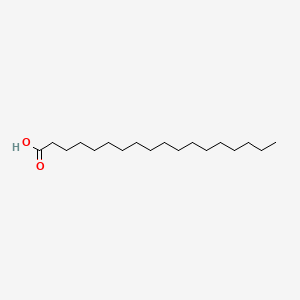| MeSH term | MeSH ID | Detail |
|---|---|---|
| Obesity, Abdominal | D056128 | 3 associated lipids |
stearic acid
stearic acid is a lipid of Fatty Acyls (FA) class. Stearic acid is associated with abnormalities such as Helminthiasis, Exanthema, Chronic disease, Obesity and Dyslipidemias. The involved functions are known as acyltransferase activity, Mutation, Cell division, cell fate and Fatty Acid Metabolism. Stearic acid often locates in membrane fraction, Mouse Liver, Membrane, Body tissue and Endoplasmic reticulum, membrane. The associated genes with stearic acid are Homologous Gene, ACLY gene, Transgenes, FATE1 gene and Alleles. The related lipids are Lysophospholipids, Stearic acid, Fatty Acids, cis-vaccenic acid and Phosphatidylserines. The related experimental models are Knock-out.
Cross Reference
Introduction
To understand associated biological information of stearic acid, we collected biological information of abnormalities, associated pathways, cellular/molecular locations, biological functions, related genes/proteins, lipids and common seen animal/experimental models with organized paragraphs from literatures.
What diseases are associated with stearic acid?
stearic acid is suspected in Obesity, Diabetes, Fatty Liver, Hyperinsulinism, Cardiovascular Diseases, Infection and other diseases in descending order of the highest number of associated sentences.
Related references are mostly published in these journals:
| Disease | Cross reference | Weighted score | Related literature |
|---|
Possible diseases from mapped MeSH terms on references
We collected disease MeSH terms mapped to the references associated with stearic acid
PubChem Associated disorders and diseases
What pathways are associated with stearic acid
There are no associated biomedical information in the current reference collection.
PubChem Biomolecular Interactions and Pathways
Link to PubChem Biomolecular Interactions and PathwaysWhat cellular locations are associated with stearic acid?
Visualization in cellular structure
Associated locations are in red color. Not associated locations are in black.
Related references are published most in these journals:
| Location | Cross reference | Weighted score | Related literatures |
|---|
What functions are associated with stearic acid?
Related references are published most in these journals:
| Function | Cross reference | Weighted score | Related literatures |
|---|
What lipids are associated with stearic acid?
Related references are published most in these journals:
| Lipid concept | Cross reference | Weighted score | Related literatures |
|---|
What genes are associated with stearic acid?
Related references are published most in these journals:
| Gene | Cross reference | Weighted score | Related literatures |
|---|
What common seen animal models are associated with stearic acid?
Knock-out
Knock-out are used in the study 'Stearic acid accumulation in macrophages induces toll-like receptor 4/2-independent inflammation leading to endoplasmic reticulum stress-mediated apoptosis.' (Anderson EK et al., 2012) and Knock-out are used in the study 'Genome-wide association study identifies novel loci associated with concentrations of four plasma phospholipid fatty acids in the de novo lipogenesis pathway: results from the Cohorts for Heart and Aging Research in Genomic Epidemiology (CHARGE) consortium.' (Wu JH et al., 2013).
Related references are published most in these journals:
| Model | Cross reference | Weighted score | Related literatures |
|---|
NCBI Entrez Crosslinks
All references with stearic acid
Download all related citations| Authors | Title | Published | Journal | PubMed Link |
|---|---|---|---|---|
| Neoptolemos JP and Thomas BS | Erythrocyte membrane stearic acid: oleic acid ratios in colorectal cancer using tube capillary column gas liquid chromatography. | 1990 | Ann. Clin. Biochem. | pmid:2310156 |
| Blackett PR et al. | Hyperlipidemia in acute lymphoblastic leukemia. | 1984 Mar-Apr | Ann. Clin. Lab. Sci. | pmid:6585175 |
| Saarni H et al. | Erythromycin levels in serum during treatment with erythromycin stearate and base. | 1979 | Ann. Clin. Res. | pmid:397800 |
| Mäntylä R et al. | Bioavailability and effect of food on the gastrointestinal absorption of two erythromycin derivatives. | 1978 | Ann. Clin. Res. | pmid:367255 |
| LEFEBVRE P and HENRIOUL F | [INFLUENCE OF GLUCAGON ON THE BLOOD LEVEL AND ARTERIO-VENOUS DIFFERENCE OF UNESTERIFIED FATTY ACIDS]. | 1963 Sep-Oct | Ann. Endocrinol. (Paris) | pmid:14092350 |
| Jang Y et al. | Low-calorie structured lipid synthesis by lipase-catalyzed transesterification. | 1998 | Ann. N. Y. Acad. Sci. | pmid:9928107 |
| Sakai T et al. | Chorea-acanthocytosis: abnormal composition of covalently bound fatty acids of erythrocyte membrane proteins. | 1991 | Ann. Neurol. | pmid:1832532 |
| Kirtsreesakul V et al. | Microbiology and antimicrobial susceptibility patterns of commensal flora in the middle nasal meatus. | 2008 | Ann. Otol. Rhinol. Laryngol. | pmid:19140538 |
| Roguinsky M and Serieys F | [Treatment of mastitis in dry cows: treatment of all cows vs treatment of infected cows only (author's transl)]. | 1977 | Ann. Rech. Vet. | pmid:606146 |
| Naidu KA et al. | P53 enhances ascorbyl stearate-induced G2/M arrest of human ovarian cancer cells. | 2007 Nov-Dec | Anticancer Res. | pmid:18225552 |
